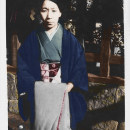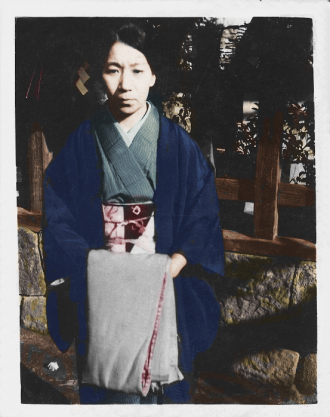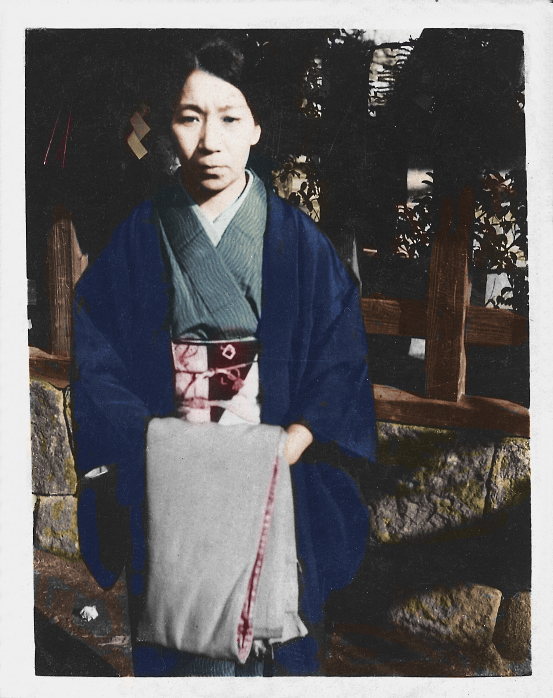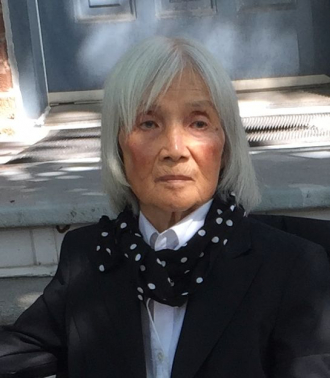Matsue was born in 1896 to the Tamura family in the Tokushima region on Shikoku island of southern Japan. Eldest of 5 (?) siblings, she, with her elderly grandmother, took over the care and education of the younger siblings when her mother died in childbirth. Matsue’s young life was largely devoted to the care of her younger siblings who remained enduringly grateful for her sacrifice.
Eventually Matsue married and was happy for a few years and bore her husband a son. Then suddenly, while their son was still a baby, her husband died in an accident at the docks where he worked. Matsue's family quickly decided that Matsue was young enough to remarry and her child, in accordance with acceptable customs of the time, was forcibly taken from her and given to her brother-in-law whose childless marriage left him without heirs. Matsue only saw her son once many years later when he as a young man stopped for a few minutes at the train station in Osaka. Matsue brought along little Taneko who looked on from a repectful distance as a few short, curt words were exchanged and then he was gone. She cried bitter tears when he left but the long-estranged son never looked back.
Matsue did later remarry in a marriage arranged by her family to a resectable older gentleman, Tetsutaro Hino, originally a native of Kamojima, also on Shikoku island. They moved to a lower middle-class neighborhood in the Nishiyodogawa-ku ward in Osaka. Matsue gave birth to two daughters, Shizuko in 1918 and Taneko in 1923. Matsue was pregnant with Taneko in the year of the Great Kanto earthquake of 1923 that shook Osaka and all of central Japan, destroying Tokyo and causing widespread destruction. Tetsutaro was employed by the Sumitomo Bank's enterprises, while Matsue took on domestic cleaning and clothes-washing jobs to supplement the household's only-adequate income. They led a relatively simple life in the city. Tetsutaro worked as a clerk and dutifully maintained his job to take care of his family. A quiet, modest man whose rare leisure included reading and a fondness for baseball, a thrill he shared with his youngest daughter, Taneko. Matsue maintained the household, saw to the proper upbringing of her two girls and during the difficult years of the Depression, took in laundry. On rare occasions, she enjoyed short excursions with her family, mostly within Osaka, to visit the prominent sights, the shrines and family outings in the nearby parks where she enjoyed the picnics, socializing, games for the children and the communal activities such as odori (dances). Matsue was a loving mother who readily sacrificed her own well-being for the little joys she could bring to her family.
With time, it was expected that her daughters should marry and a suitable match was found for the eldest daughter Shizuko. Later, a marriage was arranged as well for the younger daughter, Taneko, however Taneko had different ideas about love and marriage and successfully resisted family pressure, much to their displeasure. Matsue and her husband had little choice but to assent.
With the outbreak of war (for Japan in 1937), the family's lives were changed forever. As Japan's fortunes waned in the conflict, life became more and more difficult Rationing, lack of medical care, deprivation, intense stress, illness, death, grief and fear became the commonplace of everyday living. As the Allies inched closer to the Japanese Homeland, aerial bombardments became more frequent and devastating. While the two girls were sent away for a short visit to the relative safety of Shikoku island, Tetsutaro, the quiet, gentle patriarch, succumbed to a heart attack in 1944. When the two girls returned to Osaka a few days later, their father had already been buried. Matsue grieved the loss of her husband but remained in the city with her two daughters and son-in-law. In the final year of the war, Osaka, the second largest city in Japan and a major industrial center became a prime target for American B-29 bombers. Massed air raids unleashed thousands of tons of high-explosive and incendiary bombs that set the city ablaze and leveled 80% of the structures in the nearby core of Osaka. Matsue prepared her family for the dash to the air raid shelters and always kept on hand some essentials such as grains, rice and sweet potatoes to sustain them while waiting for the all clear. Having grown up in the country, Matsue had learned which common wild plants and herbs were comestible and how to prepare them. This served her in good stead when she and the girls scavenged edible wild vegetation that grew right under the noses of the starving city population. By the end of the war, rations had grown so meager that even money and gold could not buy the scarce food available. However, the stress of the last few years of the war took their toll on Matsue and her health declined. The occasional pains in her stomach became chronic but no medical aid was available for her as in any case it was rationed in priority to the military and to the younger people who the administration considered had a better chance of survival.
Despite the best efforts of the government to censor or put events and news in a positive light, each day’s news brought home the realization to the ordinary Japanese that a final decisive invasion was inevitable and imminent. Both the Japanese military and the population braced for what was expected to be a very bloody American invasion. The heroism and devotion of the Japanese schoolgirls who had taken up arms and died in defense of Okinawa and Saipan was in the minds of many as they were now forced to confront the decision of how they were to defend their homeland. In some cases, entire families contemplated mass suicide rather than surrender. Even Matsue’s own daughter, Taneko, had received some elementary training for the Homeland defense.
Matsue and her family, like all of Japan, held their breath in dread. In August 1945, Nagasaki and Hiroshima were obliterated by atomic bombs, the land-hungry Soviet Union declared war on Japan and as a great Allied invasion force gathered across the waters, Emperor Hirohito did the unexpected. The Japanese people heard for the first time the voice of their revered Emperor Hirohito as he announced in the antique dialect of the Imperial Court the surrender of Japan, urging his people to “endure the unendurable”. Matsue and her daughters, like most Japanese wept tears of sadness for the downfall of Japan but, also like most Japanese, were secretly relieved that this horrible war was finally over.



 George Erles
George Erles  Daniel Pinna
Daniel Pinna 


